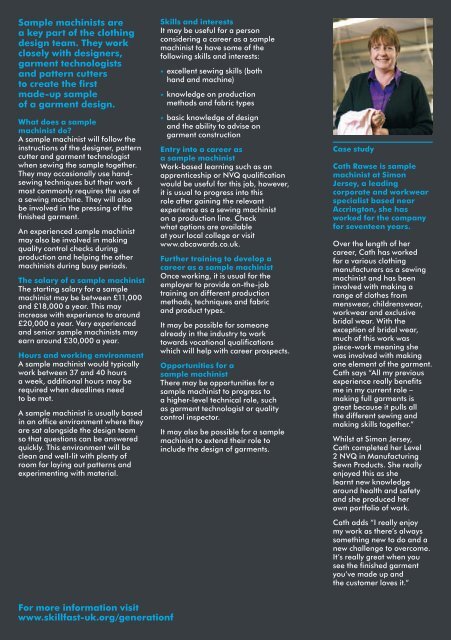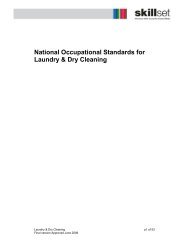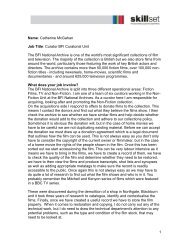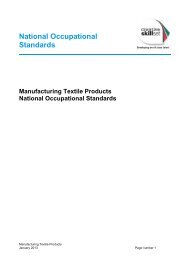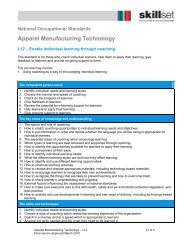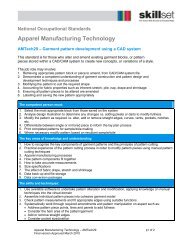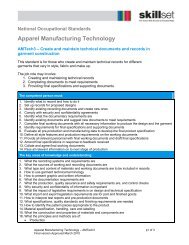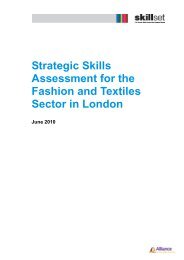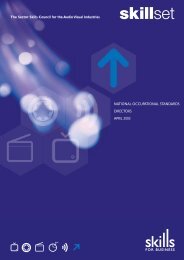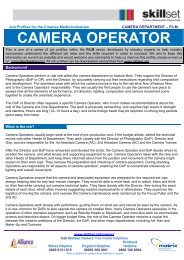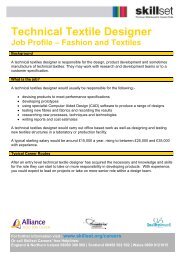CAREER PROFILE CLOTHING ALTERATION HAND - Skillset
CAREER PROFILE CLOTHING ALTERATION HAND - Skillset
CAREER PROFILE CLOTHING ALTERATION HAND - Skillset
You also want an ePaper? Increase the reach of your titles
YUMPU automatically turns print PDFs into web optimized ePapers that Google loves.
Sample machinists are<br />
a key part of the clothing<br />
design team. They work<br />
closely with designers,<br />
garment technologists<br />
and pattern cutters<br />
to create the first<br />
made-up sample<br />
of a garment design.<br />
What does a sample<br />
machinist do<br />
A sample machinist will follow the<br />
instructions of the designer, pattern<br />
cutter and garment technologist<br />
when sewing the sample together.<br />
They may occasionally use handsewing<br />
techniques but their work<br />
most commonly requires the use of<br />
a sewing machine. They will also<br />
be involved in the pressing of the<br />
finished garment.<br />
An experienced sample machinist<br />
may also be involved in making<br />
quality control checks during<br />
production and helping the other<br />
machinists during busy periods.<br />
The salary of a sample machinist<br />
The starting salary for a sample<br />
machinist may be between £11,000<br />
and £18,000 a year. This may<br />
increase with experience to around<br />
£20,000 a year. Very experienced<br />
and senior sample machinists may<br />
earn around £30,000 a year.<br />
Hours and working environment<br />
A sample machinist would typically<br />
work between 37 and 40 hours<br />
a week, additional hours may be<br />
required when deadlines need<br />
to be met.<br />
A sample machinist is usually based<br />
in an office environment where they<br />
are sat alongside the design team<br />
so that questions can be answered<br />
quickly. This environment will be<br />
clean and well-lit with plenty of<br />
room for laying out patterns and<br />
experimenting with material.<br />
Skills and interests<br />
It may be useful for a person<br />
considering a career as a sample<br />
machinist to have some of the<br />
following skills and interests:<br />
* excellent sewing skills (both<br />
hand and machine)<br />
*<br />
*<br />
knowledge on production<br />
methods and fabric types<br />
basic knowledge of design<br />
and the ability to advise on<br />
garment construction<br />
Entry into a career as<br />
a sample machinist<br />
Work-based learning such as an<br />
apprenticeship or NVQ qualification<br />
would be useful for this job, however,<br />
it is usual to progress into this<br />
role after gaining the relevant<br />
experience as a sewing machinist<br />
on a production line. Check<br />
what options are available<br />
at your local college or visit<br />
www.abcawards.co.uk.<br />
Further training to develop a<br />
career as a sample machinist<br />
Once working, it is usual for the<br />
employer to provide on-the-job<br />
training on different production<br />
methods, techniques and fabric<br />
and product types.<br />
It may be possible for someone<br />
already in the industry to work<br />
towards vocational qualifications<br />
which will help with career prospects.<br />
Opportunities for a<br />
sample machinist<br />
There may be opportunities for a<br />
sample machinist to progress to<br />
a higher-level technical role, such<br />
as garment technologist or quality<br />
control inspector.<br />
It may also be possible for a sample<br />
machinist to extend their role to<br />
include the design of garments.<br />
Case study<br />
Cath Rawse is sample<br />
machinist at Simon<br />
Jersey, a leading<br />
corporate and workwear<br />
specialist based near<br />
Accrington, she has<br />
worked for the company<br />
for seventeen years.<br />
Over the length of her<br />
career, Cath has worked<br />
for a various clothing<br />
manufacturers as a sewing<br />
machinist and has been<br />
involved with making a<br />
range of clothes from<br />
menswear, childrenswear,<br />
workwear and exclusive<br />
bridal wear. With the<br />
exception of bridal wear,<br />
much of this work was<br />
piece-work meaning she<br />
was involved with making<br />
one element of the garment.<br />
Cath says “All my previous<br />
experience really benefits<br />
me in my current role –<br />
making full garments is<br />
great because it pulls all<br />
the different sewing and<br />
making skills together.”<br />
Whilst at Simon Jersey,<br />
Cath completed her Level<br />
2 NVQ in Manufacturing<br />
Sewn Products. She really<br />
enjoyed this as she<br />
learnt new knowledge<br />
around health and safety<br />
and she produced her<br />
own portfolio of work.<br />
Cath adds “I really enjoy<br />
my work as there’s always<br />
something new to do and a<br />
new challenge to overcome.<br />
It’s really great when you<br />
see the finished garment<br />
you’ve made up and<br />
the customer loves it.”<br />
For more information visit<br />
www.skillfast-uk.org/generationf


